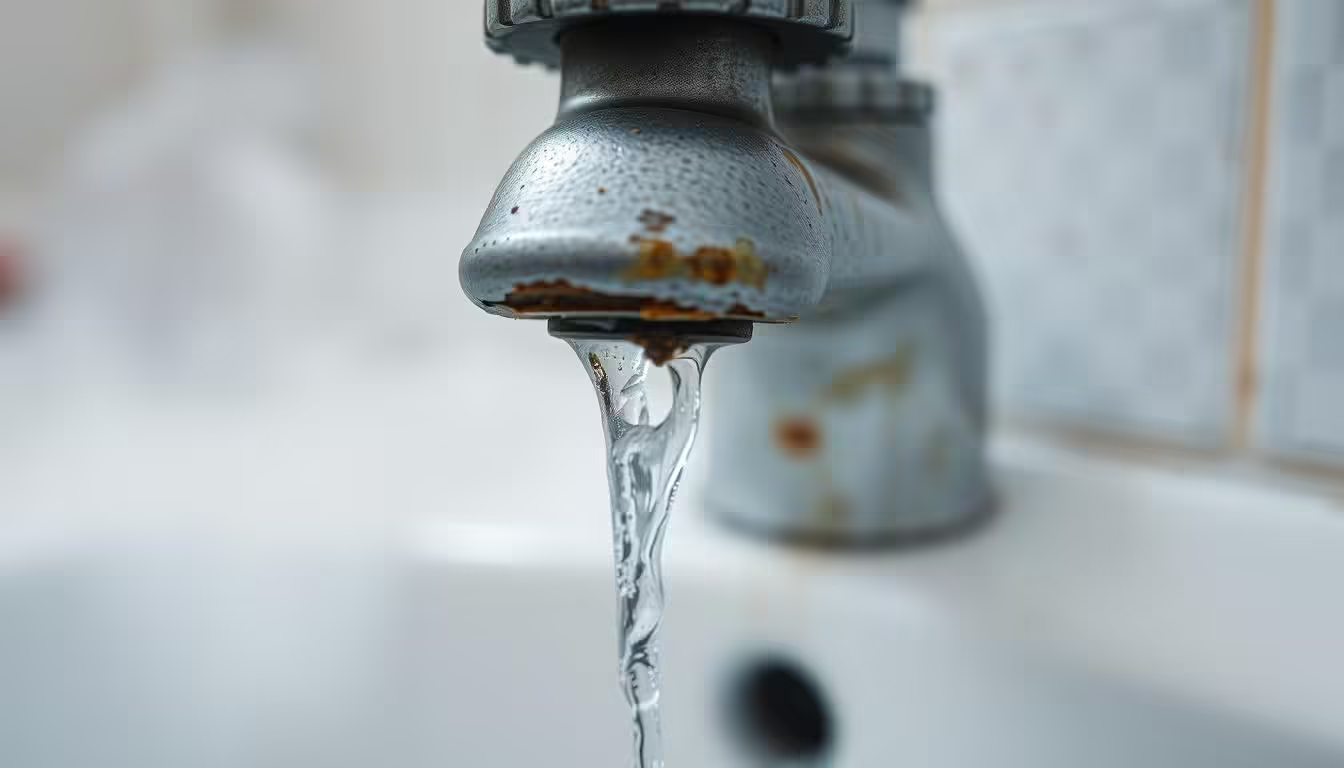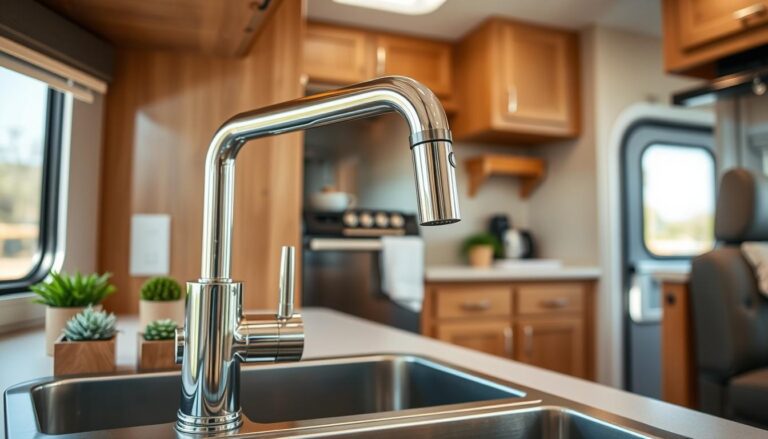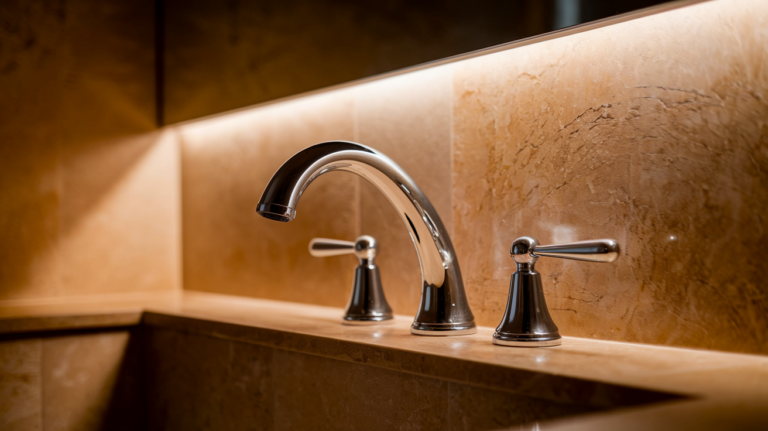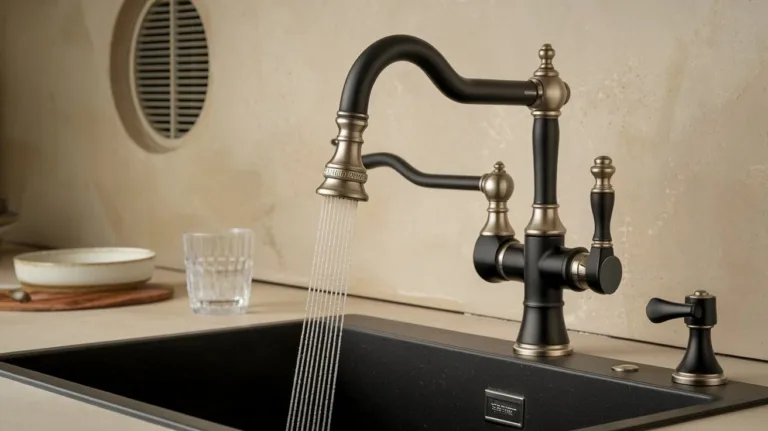Low Water Pressure in Bathroom Faucets: Causes and Solutions
Heading 3 Low water pressure in bathroom faucets can be really annoying. But, it’s a common issue that can be fixed with the right steps. We’ll look at why water pressure drops and how to fix it. This will help you get your water flowing right again.Key PointsUnderstand the factors that affect water pressure in bathroom faucetsDiagnose the root cause of low water pressure, such as clogged aerators or pipe issuesLearn effective cleaning and maintenance strategies to keep your faucets performing at their bestDiscover when to replace faulty faucet components or upgrade to a new fixtureRecognize when to seek professional assistance for persistent water pressure problemsUnderstanding Water Pressure in Bathroom FaucetsWater pressure inHeading 3 Low water pressure in bathroom faucets can be really annoying. But, it’s a common issue that can be fixed with the right steps. We’ll look at why water pressure drops and how to fix it. This will help you get your water flowing right again.Key PointsUnderstand the factors that affect water pressure in bathroom faucetsDiagnose the root cause of low water pressure, such as clogged aerators or pipe issuesLearn effective cleaning and maintenance strategies to keep your faucets performing at their bestDiscover when to replace faulty faucet components or upgrade to a new fixtureRecognize when to seek professional assistance for persistent water pressure problemsUnderstanding Water Pressure in Bathroom FaucetsWater pressure in bathroom faucets is key to your daily routine. Knowing what low water pressure is and what affects it is important. It helps you find and fix any problems.What is Considered Low Water Pressure?A normal water pressure for bathroom faucets is 40 to 60 pounds per square inch (psi). If it’s below 40 psi, it’s considered low bathroom faucet water pressure. This can make the water flow weak and unsatisfactory.Factors Affecting Water PressureSeveral things can cause low water pressure in your bathroom faucet. These include:The main water supply: The pressure from the municipal or well water system can significantly impact the normal water pressure in your home.Plumbing system: Issues like clogged pipes, mineral buildup, or leaks within your home’s plumbing can reduce the water pressure reaching your faucet.Faucet design: The internal components and flow restrictors in your faucet can also affect the overall water pressure.Knowing these factors affecting water pressure helps you diagnose and fix low-pressure issues in your bathroom faucet.”Maintaining adequate bathroom faucet water pressure is essential for a comfortable and efficient daily routine.”Common Causes of Low Water Pressure in FaucetsBathroom faucets with low water pressure can be really frustrating. But knowing the common causes can help you fix the problem. Issues like clogged aerators, mineral buildup, and plumbing problems can all lead to low water pressure.A clogged faucet aerator is a common problem. The aerator mixes air with water but can get blocked by minerals, dirt, or debris. This blockage reduces water pressure.Mineral buildup in the faucet’s parts is another issue. Hard water can leave deposits that slow down water flow. This is more common in older faucets or areas with hard water.Leaks in the plumbing system can also cause low water pressure. Even a small leak can take water away from the faucet, lowering pressure.Problems with the main water supply can also affect pressure. Issues with the municipal water line or a faulty pressure regulator can impact your faucets.Knowing these common causes helps you diagnose and fix low water pressure. This way, you can get your bathroom faucets working well again.”Maintaining optimal water pressure in your bathroom faucets is essential for a comfortable and efficient daily routine.”Diagnosing the Issue: Troubleshooting StepsWhen you notice low water pressure in your bathroom faucet, it’s important to take a step-by-step approach. We’ll explore the key steps to find and fix the problem.Checking the Main Water SupplyStart by checking the main water supply. Turn on other faucets in your home. This will help you see if the low pressure is just in the bathroom or if it’s a bigger issue. If it’s everywhere, it might mean a problem with the main water line or the city’s water supply.Inspecting the Faucet AeratorA clogged or damaged faucet aerator can also cause low water pressure. The aerator mixes air with water, making the flow steady. But, it can get blocked by mineral buildup, debris, or small objects. Taking it apart and checking it can solve this problem.By following these steps, you can find out why your bathroom faucet has low water pressure. We’ll share more solutions next.Faucet water pressureIf your bathroom faucet has low water pressure, there are ways to fix it. You can try simple fixes or more detailed upgrades. We’ll show you how to make your faucet work better.Adjusting the Faucet ValvesOne quick fix is to adjust the shut-off valves under the sink. Turn these valves clockwise to let more water flow. But, don’t overdo it to avoid valve damage.Replacing Worn WashersWorn-out rubber washers inside the faucet can slow down water flow. Find the washers and swap them for new ones. This simple change can help your water pressure.Upgrading to a Pressure-Boosting DeviceIf low pressure is a big problem, think about a water pressure booster. These devices, mounted on the faucet or in-line, pump more water. This makes your faucet’s water flow better. Look for the right one for your needs.SolutionEffectivenessComplexityCostAdjusting Faucet ValvesModerateLowLowReplacing WashersModerateLowLowInstalling Pressure BoosterHighModerateModerateTrying these solutions can make your faucet’s water flow better. This makes your bathroom sink more enjoyable. Always be safe and get help if you’re unsure or have complex plumbing problems.”Improving faucet water pressure can completely transform your bathroom experience, making daily tasks more efficient and enjoyable.”Cleaning and Maintenance TipsKeeping your bathroom faucet clean and working well is key for good water pressure. Regular cleaning and upkeep can make your faucet last longer and work better. We’ll show you how to clean and maintain your faucet effectively.Faucet Cleaning EssentialsTo clean your faucet, you’ll need a few basic tools and supplies:Mild, non-abrasive cleaning solution or vinegarSoft-bristled brush or toothbrushClean, lint-free clothStart by taking off the faucet aerator and soaking it in vinegar to remove mineral buildup. Use the soft-bristled brush to clean the aerator, then rinse it well with water. Next, clean the faucet’s visible parts with the solution and cloth, focusing on hard-to-reach spots.Regular Faucet MaintenanceRegular upkeep is also crucial for your faucet’s performance. This includes:Checking for Leaks: Look for leaks often, as they can lower water pressure.Lubricating Moving Parts: Use faucet-safe lubricant on moving parts like the handle and stem for smooth operation.Replacing Washers and Seals: Replace worn-out washers and seals to prevent leaks and maintain water pressure.Faucet Cleaning FrequencyFaucet Maintenance FrequencyMonthlyAnnuallyQuarterlyEvery 2-3 YearsBi-AnnuallyAs NeededBy following these faucet cleaning and maintenance tips, you can keep your bathroom faucet care routine effective. This ensures your faucet works well, with great water pressure and a longer life.”Regular cleaning and maintenance are the keys to keeping your bathroom faucet in top shape.”Replacing Faulty Faucet ComponentsIf your bathroom faucet has low water pressure, it might need new parts or a whole new faucet. Knowing when to change the faucet cartridge and how to upgrade can help a lot. This can bring back the water flow you want.When to Replace the Faucet CartridgeThe faucet cartridge is key for controlling water flow and pressure. It can wear out, get clogged, or damaged over time. This can cause low water pressure. Look out for these signs:Dripping or leaky faucetFluctuating water pressureDifficulty turning the faucet handleVisible wear or damage to the cartridgeReplacing the faucet cartridge is a simple faucet component replacement job. It can often fix low water pressure problems.Upgrading to a New FaucetIf the problem doesn’t go away or your faucet is old, think about upgrading to a new faucet. Look for faucets with high-flow aerators and better water pressure. Also, choose modern designs that improve your bathroom’s look and function.Fixing faulty parts or getting a new faucet can solve low water pressure. By figuring out the problem and making the right changes, you’ll get a better faucet experience.Addressing Pipe IssuesLow water pressure in your bathroom faucets might not always be the faucet’s fault. Often, the real problem is in your plumbing system, especially the pipes. Clogs and leaks can greatly reduce water pressure, making it hard to use your faucets.Checking for Clogs and LeaksTo tackle pipe issues, start by checking your plumbing system for blockages or leaks. Here’s how:Look under the sink for signs of clogging, like debris or mineral buildup.Check the main water line for kinks, cracks, or damage that could cause leaks.Use a plumbing snake or auger to clear clogs in pipes leading to your faucet.Watch for damp spots or water stains around the pipes, signs of leaks.If you find plumbing pipe issues, like pipe clogs or pipe leaks, fix them quickly. This will help restore water pressure to your bathroom faucets.”Addressing pipe problems is a crucial step in resolving low water pressure in your bathroom faucets. Don’t ignore these potential issues, as they can have a significant impact on your overall water system.”By fixing any pipe problems, you can make sure your bathroom faucets work well. This will give you the water pressure you need for comfort and efficiency.Professional Assistance for Persistent ProblemsDealing with stubborn low water pressure in your bathroom faucet? It might be time to call in the experts. Professional plumbing services have the skills to tackle even the toughest bathroom faucet repair challenges.If DIY fixes haven’t worked, a plumber can be a big help. They’ll do a detailed check, find the problem, and fix it for good. They can fix pipes and replace parts, making sure your faucet works perfectly.Don’t wait if you’re still dealing with low water pressure. A trusted plumbing company can save you time and money. They’ll make sure your faucet has the water flow you need, hassle-free.FAQWhat is considered low water pressure in bathroom faucets?Water pressure under 40 PSI is usually low for bathroom faucets. The best pressure is between 40-80 PSI for comfort and performance.What factors can affect water pressure in bathroom faucets?Several things can change water pressure in bathroom faucets. These include the main water supply, plumbing system age and condition, faucet design, and pipe clogs or leaks.What are the common causes of low water pressure in bathroom faucets?Low water pressure often comes from clogged aerators, mineral buildup, leaks, main water supply issues, and faulty faucet components.How can I diagnose the cause of low water pressure in my bathroom faucet?Start by checking the main water supply and the faucet aerator for clogs. Look for leaks in the plumbing system. This helps find the problem.What are some solutions to increase water pressure in a bathroom faucet?To improve water pressure, adjust faucet valves, replace washers, clean the aerator, or install a pressure-boosting device.How can proper cleaning and maintenance help maintain water pressure in my bathroom faucet?Cleaning and maintaining your faucet regularly can keep water pressure high. Remove and clean the aerator, descale, and lubricate the components.When should I consider replacing the faucet cartridge or upgrading to a new faucet?If maintenance and troubleshooting don’t fix the issue, you might need a new faucet cartridge or a new faucet. This is especially true for old faucets or when problems persist.How can pipe issues contribute to low water pressure in my bathroom faucet?Pipe problems like clogs or leaks can greatly reduce water pressure. Fixing these issues is key to solving low water pressure.When should I consider seeking professional assistance for my bathroom faucet’s low water pressure?If you’ve tried everything and the problem still exists, get a professional plumber. They can find and fix complex issues. bathroom faucets is key to your daily routine. Knowing what low water pressure is and what affects it is important. It helps you find and fix any problems.What is Considered Low Water Pressure?A normal water pressure for bathroom faucets is 40 to 60 pounds per square inch (psi). If it’s below 40 psi, it’s considered low bathroom faucet water pressure. This can make the water flow weak and unsatisfactory.Factors Affecting Water PressureSeveral things can cause low water pressure in your bathroom faucet. These include:The main water supply: The pressure from the municipal or well water system can significantly impact the normal water pressure in your home.Plumbing system: Issues like clogged pipes, mineral buildup, or leaks within your home’s plumbing can reduce the water pressure reaching your faucet.Faucet design: The internal components and flow restrictors in your faucet can also affect the overall water pressure.Knowing these factors affecting water pressure helps you diagnose and fix low-pressure issues in your bathroom faucet.”Maintaining adequate bathroom faucet water pressure is essential for a comfortable and efficient daily routine.”Common Causes of Low Water Pressure in FaucetsBathroom faucets with low water pressure can be really frustrating. But knowing the common causes can help you fix the problem. Issues like clogged aerators, mineral buildup, and plumbing problems can all lead to low water pressure.A clogged faucet aerator is a common problem. The aerator mixes air with water but can get blocked by minerals, dirt, or debris. This blockage reduces water pressure.Mineral buildup in the faucet’s parts is another issue. Hard water can leave deposits that slow down water flow. This is more common in older faucets or areas with hard water.Leaks in the plumbing system can also cause low water pressure. Even a small leak can take water away from the faucet, lowering pressure.Problems with the main water supply can also affect pressure. Issues with the municipal water line or a faulty pressure regulator can impact your faucets.Knowing these common causes helps you diagnose and fix low water pressure. This way, you can get your bathroom faucets working well again.”Maintaining optimal water pressure in your bathroom faucets is essential for a comfortable and efficient daily routine.”Diagnosing the Issue: Troubleshooting StepsWhen you notice low water pressure in your bathroom faucet, it’s important to take a step-by-step approach. We’ll explore the key steps to find and fix the problem.Checking the Main Water SupplyStart by checking the main water supply. Turn on other faucets in your home. This will help you see if the low pressure is just in the bathroom or if it’s a bigger issue. If it’s everywhere, it might mean a problem with the main water line or the city’s water supply.Inspecting the Faucet AeratorA clogged or damaged faucet aerator can also cause low water pressure. The aerator mixes air with water, making the flow steady. But, it can get blocked by mineral buildup, debris, or small objects. Taking it apart and checking it can solve this problem.By following these steps, you can find out why your bathroom faucet has low water pressure. We’ll share more solutions next.Faucet water pressureIf your bathroom faucet has low water pressure, there are ways to fix it. You can try simple fixes or more detailed upgrades. We’ll show you how to make your faucet work better.Adjusting the Faucet ValvesOne quick fix is to adjust the shut-off valves under the sink. Turn these valves clockwise to let more water flow. But, don’t overdo it to avoid valve damage.Replacing Worn WashersWorn-out rubber washers inside the faucet can slow down water flow. Find the washers and swap them for new ones. This simple change can help your water pressure.Upgrading to a Pressure-Boosting DeviceIf low pressure is a big problem, think about a water pressure booster. These devices, mounted on the faucet or in-line, pump more water. This makes your faucet’s water flow better. Look for the right one for your needs.SolutionEffectivenessComplexityCostAdjusting Faucet ValvesModerateLowLowReplacing WashersModerateLowLowInstalling Pressure BoosterHighModerateModerateTrying these solutions can make your faucet’s water flow better. This makes your bathroom sink more enjoyable. Always be safe and get help if you’re unsure or have complex plumbing problems.”Improving faucet water pressure can completely transform your bathroom experience, making daily tasks more efficient and enjoyable.”Cleaning and Maintenance TipsKeeping your bathroom faucet clean and working well is key for good water pressure. Regular cleaning and upkeep can make your faucet last longer and work better. We’ll show you how to clean and maintain your faucet effectively.Faucet Cleaning EssentialsTo clean your faucet, you’ll need a few basic tools and supplies:Mild, non-abrasive cleaning solution or vinegarSoft-bristled brush or toothbrushClean, lint-free clothStart by taking off the faucet aerator and soaking it in vinegar to remove mineral buildup. Use the soft-bristled brush to clean the aerator, then rinse it well with water. Next, clean the faucet’s visible parts with the solution and cloth, focusing on hard-to-reach spots.Regular Faucet MaintenanceRegular upkeep is also crucial for your faucet’s performance. This includes:Checking for Leaks: Look for leaks often, as they can lower water pressure.Lubricating Moving Parts: Use faucet-safe lubricant on moving parts like the handle and stem for smooth operation.Replacing Washers and Seals: Replace worn-out washers and seals to prevent leaks and maintain water pressure.Faucet Cleaning FrequencyFaucet Maintenance FrequencyMonthlyAnnuallyQuarterlyEvery 2-3 YearsBi-AnnuallyAs NeededBy following these faucet cleaning and maintenance tips, you can keep your bathroom faucet care routine effective. This ensures your faucet works well, with great water pressure and a longer life.”Regular cleaning and maintenance are the keys to keeping your bathroom faucet in top shape.”Replacing Faulty Faucet ComponentsIf your bathroom faucet has low water pressure, it might need new parts or a whole new faucet. Knowing when to change the faucet cartridge and how to upgrade can help a lot. This can bring back the water flow you want.When to Replace the Faucet CartridgeThe faucet cartridge is key for controlling water flow and pressure. It can wear out, get clogged, or damaged over time. This can cause low water pressure. Look out for these signs:Dripping or leaky faucetFluctuating water pressureDifficulty turning the faucet handleVisible wear or damage to the cartridgeReplacing the faucet cartridge is a simple faucet component replacement job. It can often fix low water pressure problems.Upgrading to a New FaucetIf the problem doesn’t go away or your faucet is old, think about upgrading to a new faucet. Look for faucets with high-flow aerators and better water pressure. Also, choose modern designs that improve your bathroom’s look and function.Fixing faulty parts or getting a new faucet can solve low water pressure. By figuring out the problem and making the right changes, you’ll get a better faucet experience.Addressing Pipe IssuesLow water pressure in your bathroom faucets might not always be the faucet’s fault. Often, the real problem is in your plumbing system, especially the pipes. Clogs and leaks can greatly reduce water pressure, making it hard to use your faucets.Checking for Clogs and LeaksTo tackle pipe issues, start by checking your plumbing system for blockages or leaks. Here’s how:Look under the sink for signs of clogging, like debris or mineral buildup.Check the main water line for kinks, cracks, or damage that could cause leaks.Use a plumbing snake or auger to clear clogs in pipes leading to your faucet.Watch for damp spots or water stains around the pipes, signs of leaks.If you find plumbing pipe issues, like pipe clogs or pipe leaks, fix them quickly. This will help restore water pressure to your bathroom faucets.”Addressing pipe problems is a crucial step in resolving low water pressure in your bathroom faucets. Don’t ignore these potential issues, as they can have a significant impact on your overall water system.”By fixing any pipe problems, you can make sure your bathroom faucets work well. This will give you the water pressure you need for comfort and efficiency.Professional Assistance for Persistent ProblemsDealing with stubborn low water pressure in your bathroom faucet? It might be time to call in the experts. Professional plumbing services have the skills to tackle even the toughest bathroom faucet repair challenges.If DIY fixes haven’t worked, a plumber can be a big help. They’ll do a detailed check, find the problem, and fix it for good. They can fix pipes and replace parts, making sure your faucet works perfectly.Don’t wait if you’re still dealing with low water pressure. A trusted plumbing company can save you time and money. They’ll make sure your faucet has the water flow you need, hassle-free.FAQWhat is considered low water pressure in bathroom faucets?Water pressure under 40 PSI is usually low for bathroom faucets. The best pressure is between 40-80 PSI for comfort and performance.What factors can affect water pressure in bathroom faucets?Several things can change water pressure in bathroom faucets. These include the main water supply, plumbing system age and condition, faucet design, and pipe clogs or leaks.What are the common causes of low water pressure in bathroom faucets?Low water pressure often comes from clogged aerators, mineral buildup, leaks, main water supply issues, and faulty faucet components.How can I diagnose the cause of low water pressure in my bathroom faucet?Start by checking the main water supply and the faucet aerator for clogs. Look for leaks in the plumbing system. This helps find the problem.What are some solutions to increase water pressure in a bathroom faucet?To improve water pressure, adjust faucet valves, replace washers, clean the aerator, or install a pressure-boosting device.How can proper cleaning and maintenance help maintain water pressure in my bathroom faucet?Cleaning and maintaining your faucet regularly can keep water pressure high. Remove and clean the aerator, descale, and lubricate the components.When should I consider replacing the faucet cartridge or upgrading to a new faucet?If maintenance and troubleshooting don’t fix the issue, you might need a new faucet cartridge or a new faucet. This is especially true for old faucets or when problems persist.How can pipe issues contribute to low water pressure in my bathroom faucet?Pipe problems like clogs or leaks can greatly reduce water pressure. Fixing these issues is key to solving low water pressure.When should I consider seeking professional assistance for my bathroom faucet’s low water pressure?If you’ve tried everything and the problem still exists, get a professional plumber. They can find and fix complex issues.






3 Comments